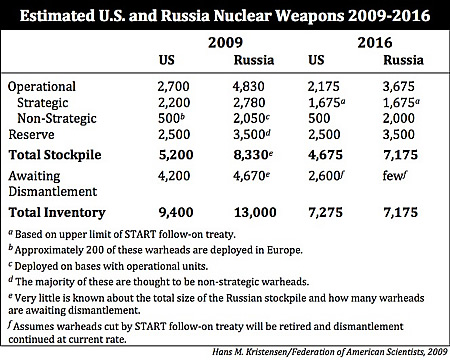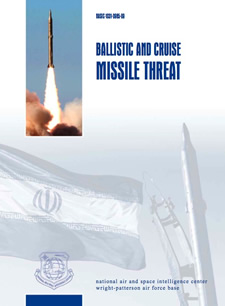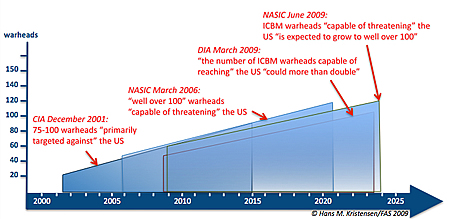Estimated Nuclear Weapons Locations 2009
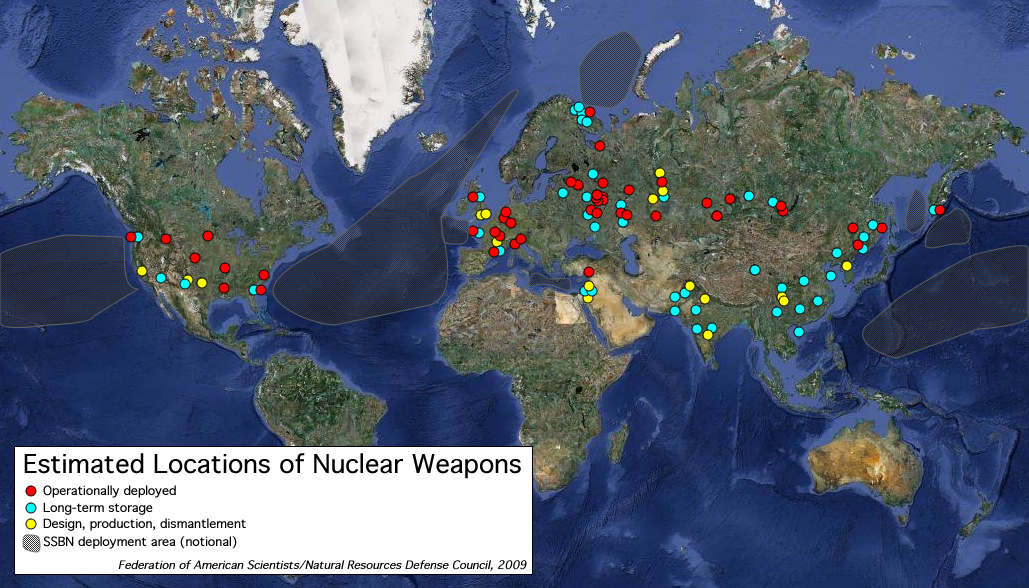
Some 23,300 nuclear weapons are stored at 111 locations around the world
.The world’s approximately 23,300 nuclear weapons are stored at an estimated 111 locations in 14 countries, according to an overview produced by FAS and NRDC.
Nearly half of the weapons are operationally deployed with delivery systems capable of launching on short notice.
The overview is published in the Bulletin of the Atomic Scientists and includes the July 2009 START memorandum of understanding data. A previous version was included in the annual report from the International Panel of Fissile Materials published last month.
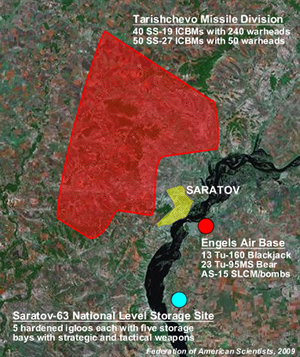
More than 1,000 nuclear weapons surround Saratov.
Russia has an estimated 48 permanent nuclear weapon storage sites, of which more than half are on bases for operational forces. There are approximately 19 storage sites, of which about half are national-level storage facilities. In addition, a significant number of temporary storage sites occasionally store nuclear weapons in transit between facilities.
This is a significant consolidation from the estimated 90 Russian sites ten years ago, and more than 500 sites before 1991.
Many of the Russian sites are in close proximity to each other and large populated areas. One example is the Saratov area where the city is surrounded by a missile division, a strategic bomber base, and a national-level storage site with probably well over 1,000 nuclear warheads combined (Figure 2).
The United States stores its nuclear weapons at 21 locations in 13 states and five European countries. This is a consolidation from the estimated 24 sites ten year ago, 50 at the end of the Cold War, and 164 in 1985 (see Figure 3).
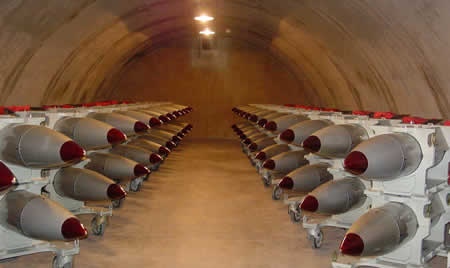
Approximately 50 B61 nuclear bombs inside an igloo at what might be Nellis Air Force Base in Nevada. Seventy-five igloos at Nellis store “one of the largest stockpile in the free world,” according to the U.S. Air Force, one of four central storage sites in the United States.
Europe has about the same number of nuclear weapon storage locations as the Continental United States, with weapons scattered across seven countries. This includes seven sites in France and four in Britain. Five non-nuclear NATO countries (Belgium, Germany, Italy, the Netherlands, and Turkey) still host U.S. nuclear weapons first deployed there during the Cold War.
We estimate that China has 8-14 facilities associated with nuclear weapons, most likely closer to the lower number, near bases with units that operate nuclear missiles or aircraft. None of the weapons are believed to be fully operational but stored separate from delivery vehicles at sites controlled by the Central Military Commission.
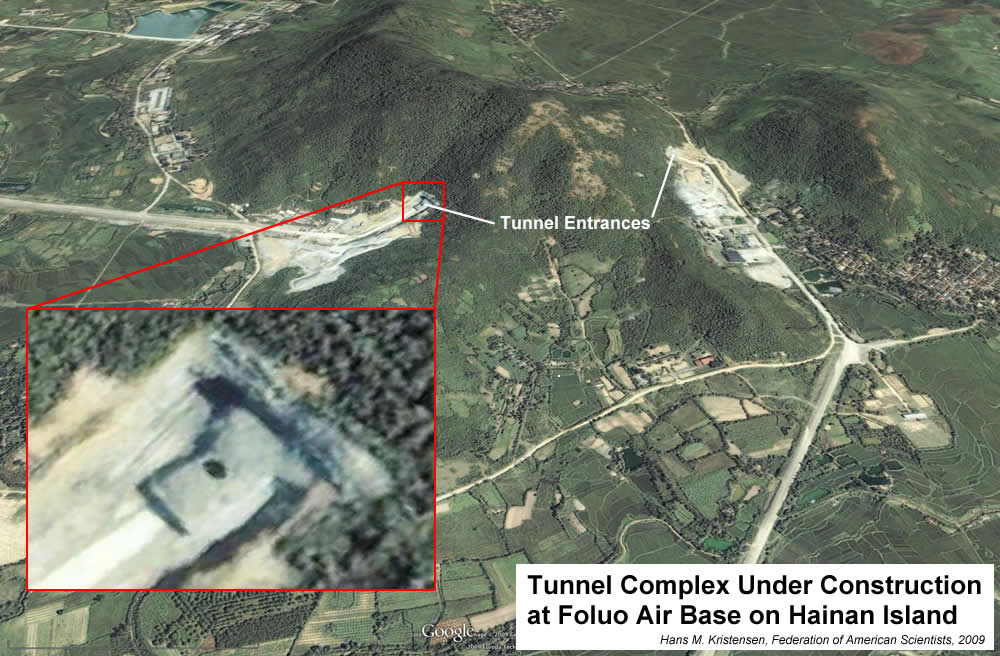
Where does China store nuclear warheads for its ballistic missile submarines? The naval base near Julin on Hainan Island has extensive underground facilities. An alternative to the base itself could potentially be a facility elsewhere on the island, such as Foluo Air Base where construction of an underground facility began five years before the first SSBN arrived at Hainan. Or are the weapons stored on the mainland? Click image to enlarge.
Israel probably has about four nuclear sites, whereas the nuclear storage facilities in India and Pakistan are – despite many rumors – largely undetermined. All three countries are thought to store warheads separate from delivery vehicles.
Despite two nuclear tests and many rumors, we are unaware of publicly available evidence that North Korea has operationalized its nuclear weapons capability.
Warhead concentrations vary greatly from country to country. With 13,000 warheads at 48 sites, Russian stores an average of 270 warheads at each location. The U.S. concentration is much higher with an average of 450 warheads at each location. These are averages, however, and in reality the distribution is thought to be much more uneven with some sites only storing tens of warheads.
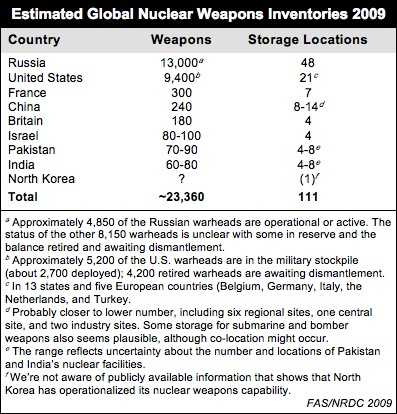
Finally, a word of caution is in order: estimates such as these obviously come with a great deal of uncertainty, as we don’t have access to classified intelligence estimates. Based on publicly available information and our own assumptions we have nonetheless produced a best estimate that we hope will assist the public debate. Comments and suggestions are encouraged so we can adjust the overview in the future.
This publication was made possible by a grant from Carnegie Corporation of New York and Ploughshares Fund. The statements made and views expressed are solely the responsibility of the author.
Clinton On Nuclear Preemption
 |
|
No preemptive nuclear options, according to Secretary of State Hillary Clinton. |
By Hans M. Kristensen
During an interview with Ekho Moskvy Radio last week, Secretary of State Hillary Rodham Clinton was asked if “the American [nuclear] doctrine incorporate[s] preemptive nuclear strikes against an aggressor?”
The Secretary’s answer was: “No, no.”
Ahem….
Secretary Clinton’s denial that U.S. nuclear doctrine incorporates preemptive strike options is at odds with numerous statements made by U.S. government officials over the past eight years, who have sought to give precisely the opposite impression; that the nuclear doctrine does indeed also contains preemptive options. An draft revision of U.S. nuclear doctrine in 2005 revealed such options.
So unless the U.S. has changed its nuclear doctrine since the Bush administration, then the Secretary’s denial is, well, at odds with the doctrine.
The confusion could of course be academic; that Secretary Clinton is under the impression that the doctrine includes preventive, no preemptive, strike options. Or perhaps she simply doesn’t know, yet believes that preemptive nuclear strike options should not be part of U.S. nuclear doctrine. It is of course important that the U.S. Secretary of State knows what U.S. nuclear policy is, since she is in charge of negotiations with Russia about the START Follow-On treaty and laying the groundwork for a subsequent and more substantial treaty and nuclear relationship.
The context of her denial was an Izvestia interview with Nikolai Patrushev, Secretary of Russia’s Security Council, about Russia’s ongoing review of its nuclear doctrine. Mr. Patrushev reportedly said: “In situations critical to national security, a nuclear strike, including a preventative one, against an aggressor is not ruled out.”
Russia’s current doctrine already allows preemptive strikes, something the Kremlin says it needs because of Russian inferior conventional forces. Whether the new revision will change or reaffirm preemptive options remains to be seen.
Background: Counterproliferation and US Nuclear Strategy (2009); Global Strike Chronology (2006); Doctrine for Joint Nuclear Operations (2005)
This publication was made possible by a grant from Carnegie Corporation of New York and Ploughshares Fund. The statements made and views expressed are solely the responsibility of the author.
The Big Picture – what is really at stake with the START follow-on Treaty
by Alicia Godsberg
There is cause for cautious optimism after Presidents Obama and Medvedev signed their START follow-on Joint Understanding in Moscow last Monday – the goal of completing a legally binding bilateral nuclear disarmament agreement with verification measures is preferable to letting START expire without an agreement or without one that keeps some sort of verification protocol. The Joint Understanding leaves some familiar questions open, such as the lack of definition of a “strategic offensive weapon” and what to do about the thousands of nuclear warheads in reserve or awaiting dismantlement. But so far few analysts on either side of the nuclear debate have been talking about the big picture, what for the vast majority of the world (and therefore our own national security) is really at stake here – the viability of the nonproliferation regime itself.
Why will the follow-on treaty to START have such a great impact on the entire nonproliferation regime? Simply, the rest of the world is looking for the possessors of 95% of the global nuclear weapon stockpiles to show greater effort in working toward their nuclear disarmament obligation under the Treaty on the Nonproliferation of Nuclear Weapons (NPT). The NPT is both a nonproliferation and disarmament treaty, and at the NPT Review Conferences (RC’s) and Preparatory Committees (PrepCom’s) the Non-Nuclear Weapons States Parties (NNWS) continue to voice their growing concern and anger over what they perceive to be lack of real progress on nuclear disarmament. At the PrepCom this past May those voices – including many of our closest allies – spoke loudly, stating that continued failure by the NWS to work in good faith toward their nuclear disarmament obligation could eventually break up the nonproliferation regime, spelling the end of the other part of the Treaty’s bargain: the nonproliferation of nuclear weapons.
Just to put things in perspective, NNWS are every country in the world except the five NWS (US, Russia, UK, France, and China) and the three countries that have never signed the NPT (Israel, India, and Pakistan – with a question now about the obligations of North Korea and without including Taiwan, which is not recognized by the United Nations). While the NPT has an elaborate mechanism to verify the compliance of NNWS with their nonproliferation obligations under the Treaty (i.e. the IAEA and its Safeguards Agreements), there are no institutionalized means to monitor or enforce compliance with the disarmament obligation of NWS under Article VI of the Treaty. And while some NWS are now proposing further restrictions on NNWS nuclear energy programs through preventing the spread of sensitive fuel-cycle technology, NNWS are increasingly voicing their frustration over nuclear trade restrictions while greater progress on nuclear disarmament remains in some distant future. Further fueling this distrust of the NWS and of new technology transfer restrictions was the Bush administration’s ill-advised US-India nuclear cooperation deal, seen by many NNWS as “rewarding” India with an exception to nuclear trade laws and export controls while India continues to operate its nuclear programs largely outside the NPT’s nonproliferation regime and its oversight and restrictions.
This blog is not meant to weigh in on the controversy surrounding the inalienable right of NNWS to nuclear technology under Article IV of the NPT, but rather to state the fact that a series of what are perceived as broken promises by NWS to NNWS has led the regime to approach what many have seen as a breaking point. Some of those promises include the ratification of the CTBT, strengthening of the ABM Treaty, and the establishment of a Nuclear Weapon Free Zone in the Middle East. These promises have special significance, as they were part of political commitments made to get the indefinite extension of the NPT in 1995, thereby removing any small pressure NNWS might have been able to place on NWS to meet their disarmament obligation by threatening not to renew the Treaty at future RC’s.
The US has a special role to play in this drama for two reasons. First, the US is the second largest possessor of nuclear weapons in the world and as such needs to be at the forefront of nuclear disarmament for that goal to be taken seriously and eventually come to fruition. Second, President Obama has publicly reversed some positions of President George W. Bush on nuclear disarmament and the world is waiting to see if his vision will be translated into action by the US. For example, at the 2005 NPT RC the Bush administration stated it would not consider as binding any of the commitments made by prior US administrations at previous RC’s, such as the commitment to the “unequivocal undertaking” to eliminate nuclear weapons and the commitment to work toward ratifying the CTBT. Contrast that with Obama’s policy speeches, especially the one in Prague on April 5, 20009 in which he placed a high priority on US verification of the CTBT and on his vision of a world free of nuclear weapons, and you can begin to understand the feeling of hope surrounded by a continued atmosphere of mistrust that pervaded the United Nations in May.
A recent New York Times op-ed[i] pointed out that there is no guarantee the US Senate is going to go along with President Obama’s nuclear policy vision, and he may in fact encounter difficulty ratifying the CTBT and gaining support for the reductions outlined in last week’s Joint Statement. In a June 30 op-ed in the Wall Street Journal,[ii] Senator Kyl and Richard Perle voiced this side of the debate, stating:
There is a fashionable notion that if only we and the Russians reduced our nuclear forces, other nations would reduce their existing arsenals or abandon plans to acquire nuclear weapons altogether… this is dangerous, wishful thinking. If we were to approach zero nuclear weapons today, others would almost certainly try even harder to catapult to superpower status by acquiring a bomb or two. A robust American nuclear force is an essential discouragement to nuclear proliferators; a weak or uncertain force just the opposite.
This fear mongering, unsupported by the facts, is the type of rhetoric that will confuse the debate once any START or CTBT-related issues hit the Senate floor. In a world where reductions would still leave actively deployed nuclear warheads in the thousands – with thousands more on reserve – “superpower status” will not be achieved by acquiring “a bomb or two.” Think about North Korea – are they a “superpower” now that they have exploded two nuclear devices and we know they are continuing to work on their nuclear weapon program? Hardly. Instead, they are international outcasts, condemned even by China for their latest atomic experiment, and have become weaker still in their attempt to achieve international status. And if the US, the country with the most powerful and advanced conventional forces, needs a “robust” nuclear force to protect its national security and fulfill security commitments, then it seems that any country with a weaker conventional force (which is everyone else) should seek nuclear weapons. So, I would argue exactly the opposite Senator Kyl and Mr. Perle, and say that a diminishing role for nuclear weapons in US security actually lessens the case for other nations to develop their own nuclear weapons, which are more costly both economically and politically than conventional forces.
Whether the US can restore the faith of the rest of the world in our leadership on nuclear nonproliferation and disarmament by meeting previous political commitments and working toward fulfilling Treaty obligations remains to be seen. Rose Gottemoeller’s remarks to the 2009 NPT PrepCom at the UN in May were well received by the global community, but NNWS also made clear that words need to be followed by concrete actions. The US needs the cooperation of the global community to continue the success of the nonproliferation regime, which has been largely successful over the past 39 years minus the few notable failures. To do this, the US must understand that the follow-on treaty to START will directly impact the perception the rest of our global community has about the seriousness of our commitment to the NPT. That is because the NPT is both a disarmament and nonproliferation treaty; if the US recognizes and acts on this truth, it will be able to achieve the urgent goal of regaining its leadership position on the nonproliferation of nuclear weapons.
[i] Taubman, Philip. “Obama’s Big Missile Test.” Editorial. New York Times 8 July 2009.
[ii] Jon Kyl and Richard Perle. “Our Decaying Nuclear Deterrent.” Editorial. Wall Street Journal 30 June 2009.
Not Getting It Right: More Bad Reasons to Have Nuclear Weapons
A recently released report, U.S. Nuclear Deterrence in the 21st Century: Getting It Right, by the ad hoc New Deterrent Working Group with a forward by James Woolsey, is an interesting document. I believe this report is significant because it might typify the arguments that will be used against arms control treaties in the upcoming Senate debates.
Much of what is written in support of existing nuclear policies is such a logical muddle that one hardly knows where to start in a critique. As a statement of the pro-nuclear position, this paper is clearer than most so worth addressing. It makes the errors that others do when arguing for nuclear weapons, specifically, making statements about the “requirements” for nuclear weapons that imply missions left over from the Cold War, but the report is particularly blunt in its demands and might serve as a good example of the pro-nuclear arguments. The report is almost seventy pages long, so I can’t touch on every point in a blog and I think I will leave the arguments about nuclear testing for a separate blog to follow.
The report starts out with one fundamental mistake contained in almost every discussion on nuclear weapons: It conflates nuclear weapons with deterrence. Nuclear weapons are so thoroughly equated with deterrence—they are often simply called “the deterrent” —that we seldom stop to think about the details of how this deterrent is supposed to work. What is being deterred, whom, how, for what purpose? If we do not know what nuclear weapons are for, what their missions are, what their targets are, then it is impossible to pin down what their performance characteristics ought to be.
Uncertainty, Reliability, and Safety
The report argues that we need nuclear weapons in part because the world and the future are very uncertain. The report admits no one knows the answers to any of the questions above so the United States simply has to make certain that it has sufficient numbers of nuclear weapons with a variety of capabilities and hope for the best. The problem with this approach is that planning for uncertainty is never finished; we never reach an endpoint. For example, the heading on p. 25, “U.S. nuclear weapons are deteriorating and do not include all possible safety and reliability options” is not only true but always will be true. The “deteriorating” fear has been refuted: parts in weapons age, and these parts are being replaced when needed so the weapons remain within design specifications. This is not cheap or simple but neither is it impossible and can continue for decades. But admittedly, nuclear weapons do not have “all possible safety and reliability options.” There are, no doubt, “options” no one has even thought of yet. So how much reliability and safety is enough? When can we stop?
The answer depends on the missions for nuclear weapons. If nuclear weapons had only the mission of retaliating against nuclear attack, to inflict sufficient pain to make such an attack seem pointless in the first place, then one could plausibly argue that 90% reliability is adequate. If the United States needs to destroy, say, ten targets to inflict sufficient pain to deter, then which ten is not absolutely critical and it could fire at eleven targets and accept that one might escape. Even if the United States wanted to use nuclear weapons to attack and destroy stocks of chemical and biological weapons, it could fire a nuclear weapon at the target and, if one in ten does not go off, it could fire off another bomb an hour later. It is not as though we will not know whether a nuclear bomb actually went off, that will be pretty obvious. If, on the other hand, the United States wants to conduct a surprise, disarming first strike against Russian central nuclear forces, destroying its missiles on the ground, then there is a huge difference whether the attack is 90%, 95%, or 99.9% successful. If the Russians have a thousand warheads, that is the difference between 100, 50, or 1 surviving, obviously significant. So, to say that nuclear warheads need a certain reliability, specifically a high reliability, is to imply certain missions. But these are missions that nuclear advocates rarely want to acknowledge explicitly because they know what a hard sell it will be while “reliability” seems like an obvious, inarguable good quality to have.
What about safety? Certainly we should have nuclear weapons that are as safe as possible and no effort should be spared to make them safer, right? In fact, the Working Group does not agree. The safest nuclear weapons are the ones that do not exist, so ultimate safety calls for nuclear abolition, an option explicitly rejected by the Working Group. If we are going to have actual nuclear weapons, they could be made safer by storing them disassembled. If we need assembled warheads, they could be made safer by removing them from their missiles. Warheads on missiles could be made safer by taking the missiles off alert. All of these options are explicitly rejected by the Working Group. What the report really means when it says we should have “all possible” safety options is that we should fund the National Labs at high levels forever but not change deployments one iota in the interest of safety, hardly my definition of “all possible.”
How Much Is Enough?
The rest of the report makes claims that are unproven and often unprovable and sets requirements for nuclear weapons that sound as though the Cold War never ended. I understand that even in a report of seventy pages not every statement can be fully analyzed and supported but, even so, there are a score of amazing claims for nuclear weapons that are supported mostly by lots of quotes.
The report makes the error of discussing the numbers of nuclear weapons in terms of reductions, specifically since the Cold War (p. 11). All references to reductions imply the Cold War is a benchmark by which current arsenals are measured. But the world has been turned on its head since then and comparison to Cold War numbers is neither relevant nor enlightening. (The Navy also has fewer battleships than it did in World War II. The point is?)
The report states (p. 11), “In a number of cases, a robust American nuclear arsenal has proven to be effective not only in deterring attacks on the United States and its allies from adversaries using weapons of mass destruction.” This may be true but it is very hard to know. Failures of deterrence are obvious but, if some action does not happen, then why did it not happen? Was the action every really considered? Was it considered but rejected for some other reason? Or was it deterred? Arguments about the effectiveness of deterrence are inevitably going to be speculative and based on absence of evidence. As Donald Rumsfeld pointed out while Secretary of Defense, absence of evidence is not evidence of absence. There is no doubt that deterrence is real in many cases, it really works in many cases, but it is very difficult to be certain when and where. We should all (me included) be very cautious when making arguments about deterrence. I believe that general discussions of deterrence almost always go off the rails. When we talk about deterrence, we should at least try to use concrete examples for discussion. In the case of nuclear weapons, going to some example, any example, almost always demonstrates that the arguments in favor of nuclear weapons are simply incredible.
The report states (p. 12), “In short, the available evidence suggests that an American nuclear deterrent that is either qualitatively or quantitatively insufficient will have the effect of encouraging the very proliferation of nuclear forces we seek to prevent.” This might be tautologically true if the definition of “insufficient” is chosen to make it true. But there is no “available evidence” for the simple reason that the “American nuclear deterrent” (note again how nuclear weapons are thoughtlessly referred to as the “deterrent”) has never been anywhere near “insufficient” since 1945. So exactly when was this experiment conducted? Later (p. 51) the reports states, “To the contrary, history has clearly shown that unilateral US reductions, far from causing a similar response, actually stimulate nuclear buildups by adversaries.” What can they be talking about? Russia, Britain, France, and China went nuclear while the U.S. arsenal was expanding or just plain huge. The nuclear arsenal of the United States declined from its peak because of the retirement of thousands of battlefield nuclear weapons made obsolete by modern precision conventional alternatives. Did South Africa, India, Israel, Pakistan, or North Korea really go nuclear because of “unilateral US reductions”? These confident statements are based on a “history” of some parallel universe.
The report asserts that China has “its own extensive military modernization program.” China, with a growing economy is naturally increasing its overall budget but its nuclear ambitions continue to appear quite restrained. Hans Kristensen has written extensively on this.
Hydronuclear Alert
The report asserts that Russia is conducting hydronuclear tests, that is, nuclear weapon tests with very small nuclear yields, tests that the United States would consider in violation of the Comprehensive Test Ban. This is a common claim from pro-nuclear people, based, apparently on highly classified reports that are repeated here in this unclassified document. Some of the authors of the report have or had security clearances so any claim to the contrary is met with “if only you knew what I know.” All I can say is that I have asked people who do know what the authors know and apparently the evidence is unclear, specifically, the United States does not have good enough detection capability to prove that the Russians are not conducting such tests. If the Russians are conducting such tests, and the pro-nuclear lobby has already let the cat out of the bag, the intelligence community should present testimony in Congress confirming the tests. As far as I know, they have not done so. Even so, note that the fuss is about a treaty that the United States has not ratified. Upon ratification, the United States and Russia (and perhaps China) could agree in parallel to place instruments at each other’s tests sites and resolve this ambiguity.
Nuclear Weapons Ready to Fly.
The report advocates, even assumes, an aggressive nuclear stance, with weapons constantly ready to go. For example, (p. 15): “Finally, the continued credibility and effectiveness of the U.S. nuclear deterrent precludes de-mating of warheads on operational systems or otherwise reducing the alert rates or alert status of U.S. forces.” Again, we should apply this general statement to a few concrete examples. First, by arguing against reducing alert rates they are endorsing current alert rates. While the report objects to the term “hair trigger alert,’ U.S. nuclear weapons are, in fact, ready to launch on a few minutes’ notice. At any given moment, many are deployed on submarines off the coast of China and Russia, atop missiles just a few minutes flight time from their targets. Do they really mean that an enemy will not be deterred if these conditions are relaxed? We have to imagine a scenario in which the leader of China, Russia, or maybe North Korea want to use nuclear weapons against the United States but, knowing that they will be hit back 40 minutes later are deterred. Then their head of military intelligence comes in and reports that the American nuclear bombs won’t arrive until eight hours later, or perhaps the next day, or whatever, and as a result the enemy leader says, “Well, in that case, let’s attack.” Perhaps someone else can think of a case in which this is plausible but I cannot.
Later (p. 59), the report does try to give some further justification for high alerts: “They [nuclear weapons] must be known to be ready and useable to have deterrent effect. No START follow-on agreement can be deemed in the national security interest if it would require downgrading of that condition and, thereby, potentially leave the United States vulnerable to coercion based on the threat of second or third strikes before we could respond to an attack.” This actually makes some sense but we have to think about what it really means. It means keeping a constant counterforce attack capability. The statement above says that, if Russia (in the context of START, we are talking about Russia) attacks the United States with nuclear weapons, the next act of the United States should be to attack all remaining Russian nuclear weapons so they can’t do any more damage. That sounds plausible but let’s think this though. The Russians can safely assume the Americans will be more than a little upset after a nuclear bomb has gone off. The Russians will know that their vulnerable weapons could be attacked so they would either disperse their weapons to make them invulnerable or they would use them. It might be that keeping a counterforce capability results in the Russians throwing everything they can throw at the United States in the first wave, actually increasing the damage to the United States in a contest that would otherwise have smaller stakes. I have written elsewhere how high U.S. alert rates make reductions in nuclear forces more difficult for Russia. Moreover, the report completely neglects the costs of high alert rates, not just the financial costs but the risks of accidental nuclear launch, either by the United States or Russia, and the danger of Russian mitigating tactics, and the loss of escalation control. The authors fail to imagine that the United States and Russia might negotiate mutual force postures that include weapons off alert that are mutually invulnerable, creating a much more stable nuclear environment. The authors seem to believe that a Cold War Lite is the only way the world can be. They cannot see over the hill into the next valley.
The report makes a series of other remarkable and unsupportable claims, but I want to address those in a separate blog about nuclear testing.
START Follow-On: What SORT of Agreement?
 |
| Presidents Obama and Medvedev sign a joint understanding on a START follow-on treaty. |
By Hans M. Kristensen
The Joint Understanding for the START Follow-on Treaty signed by President Obama and Medvedev on July 6, 2009, commits the United States and Russia to “reduce their strategic warheads to a range of 1500-1675, and their strategic delivery vehicles to a range of 500-1100.”
Negotiators will still have to hammer out the details and draft a new treaty that the presidents can sign, hopefully by the end of the year, to be implemented in seven years.
The Summit was a good effort to revive U.S.-Russian relations, but seven years is a very long timeline for a START follow-on that doesn’t force either side to change very much. Does it rule out deeper cuts for the rest of the Obama administration?
Perceived and Actual Cuts
Although the actual treaty has yet to be written up, the Joint Understanding indicates that it will be a hybrid between the 1991 START treaty and the 2002 SORT agreement: limits on strategic delivery vehicle and deployed strategic warheads. It adopts the range-limit of the SORT agreement and continues some form of verification regime.
The lower limits of 1,500 strategic warheads and 500 delivery vehicles are meaningless because neither country is prohibited from going lower if it chooses to do so. The only real limit is the upper limit of 1,675 deployed strategic warheads and 1,100 strategic delivery vehicles.
Unfortunately, and this often happens when arms control agreements are covered, the news media has widely misreported what has been agreed to. Here are some examples:
* Washington Post: The agreement would “cut the American and Russian nuclear arsenals by as much as a third” by reducing the “the number of deployed nuclear warheads in each country to between 1,500 and 1,675….”
* Associated Press: The agreement would “slash nuclear stockpiles by about a third….”
* Washington Times: The agreement “would reduce nuclear warheads to between 1,500 and 1,675….”
In fact, the agreement only reduces deployed strategic warheads. It does not affect warheads held in reserve, non-strategic warheads, the size of the total stockpile, nor does it require dismantlement of any nuclear warheads.
The number of warheads in each country is secret and projections fraught with considerable uncertainty, but here is how the proposed START follow-on treaty might affect the nuclear arsenals of Russia and the United States:
Compared with the forces deployed as of 2009, the effect of the START follow-on appears to be a reduction of Russian deployed strategic warheads by approximately 40 percent, and a U.S. reduction of roughly 24 percent. The estimated effect on the total stockpile of either country is more modest: 14 percent fewer warheads for Russia and 10 percent for the United States. But that assumes the warheads cut by the START follow-on treaty would be retired rather than placed in the reserve, something the agreement does not require. The treaty itself requires no change in the size of the total stockpiles.
The reduction to 500-1,100 strategic delivery vehicles represents a significant reduction from the START ceiling of 1,600, at least on paper. In reality, however, the upper limit exceeds what either country currently deploys, and the lower level exceeds what Russia is expected to deploy by 2017 anyway. Therefore, a 500-1,100 limit doesn’t force either country to make changes to its nuclear structure but essentially follows current deployment plans.
The United States currently deploys approximately 798 strategic delivery vehicles; Russia approximately 620. But many of the Russian systems are being retired and not being replaced on a one-for-one basis so the entire force could shrink to less than 400 strategic delivery vehicles by 2016. To put in perspective; that would be less than the United States deploys in its ICBM force alone.
It is clear that claims that the Kremlin got everything while Washington gave away at the store are not accurate. Because Russia deploys more strategic warheads than the United States it also has to reduce more under the new treaty. And even after implementation, the United States will still have more – and better – strategic delivery vehicles than Russia.
So What?
Just like President Bush set a force level of 1,700-2,200 “operationally deployed strategic warheads” before the 2001 Nuclear Posture Review was completed, President Obama has now set what probably will be the overall force level of the ongoing Nuclear Posture Review. Not only will that review cut the number of warheads, it will probably also cut the number of delivery vehicles, perhaps a couple of the SSBNs and some of the ICBMs.
Yet some planners will probably argue against such cuts because Russia is compensating for its lower number of strategic delivery vehicles by deploying more warheads on each missile than the United States. In the minds of some, details like that still matter.
One architect of the Bush administration’s nuclear policy recently argued that the START follow-on agreement is a sellout by the Obama administration because it will “control or eliminate many elements of U.S. military power in exchange for strategic force reductions [Russia] will have to make anyway,” make the United States more vulnerable to a nuclear first strike, and make it harder to direct the nuclear force against other potential adversaries. Another warned that it would right-out “compromise” the U.S. nuclear deterrent.
Such arguments are both well known from the Cold War and out of sync with the 21st Century because they represent a cocooned form of strategic thinking that is preoccupied with Cold War scenarios. It is precisely because Russia is reducing that the United States should also trim its force; anything else will cater to those elements in Russia who want to stop and reverse the reduction. How could such a future possibly be in the interest of the United States or its allies (and, for that matter, Russia)?
And just why a U.S. arsenal of several thousand nuclear weapons would not be able to deter any other realistic adversary – to the extent anything can – is beyond me.
Internally the START follow-on will no doubt help the United States and Russia at the 2010 Review Conference of the Non-Proliferation Treaty. Yet even when the new treaty has been implemented in seven years, the two countries will still possess more than 90 percent of the world’s nuclear weapons, each with over 20 times more weapons than the next-largest nuclear power: China.
What’s Next?
Where does the new agreement fit in? It is explicitly described as a follow-on agreement to START, and U.S. and Russian officials have spoken of a step-by-step process that would initially extend START, produce a follow-on treaty, and also address non-strategic weapons and reserve warheads.
Yet the long timeline of the START follow-on agreement – seven years from the date of signing, five years after the SORT deadline – raises the question of whether this is as deep as they want to go in deployed strategic weapons. Since the limit of 1,100 delivery vehicles liberates either country from having to change their force structure, the agreement could be implemented very quickly – probably in a few months. So why set a timeline of seven years? I hope it does not rule out deeper cuts during even a second Obama administration.
Is the START follow-on the umbrella structure and the other steps – reserve weapons, counting rules, and non-strategic weapons – intended to follow underneath while it is being implemented?
Time will tell, but a couple of clarifying statements from the administration would be helpful.
Background Information: Full Text of Joint Understanding | U.S. Nuclear Forces 2009 | Russian Nuclear Forces 2009
US-Russia Summit Nuclear Weapons Information
 |
By Hans M. Kristensen
Can they do it? Expectations are high for the July Moscow Summit to produce an agreement to extent the START Treaty and commit to additional nuclear weapons reductions in the future. The following provides quick access to information about nuclear weapons numbers:
Overview of World Nuclear Forces
Global Nuclear Stockpiles, 1945-2006
US and Russian Total Nuclear Arsenals:
– Russia
– Briefing slides on history of US and Russian nuclear arsenals
US and Russian Non-Strategic Nuclear Weapons:
– US Nuclear weapons in Europe
– History of US nuclear weapons in South Korea
– Russian Tactical Nuclear Weapons
Other Nuclear Weapon States (Most Recent Overviews):
– France, China, United Kingdom, India, Pakistan, Israel, North Korea
New Air Force Intelligence Report Available
By Hans M. Kristensen
The Air Force Air and Space Intelligence Center (NASIC) has published an update to its Ballistic and Cruise Missile Threat. The document, which I obtained from NASIC, is sobering reading.
The latest update continues the previous user-friendly format and describes a number of important assessments and new developments in ballistic and cruise missiles of many of the world’s major military powers.
The report also helps dispel many web-rumors that have circulated about Chinese, Russian, Indian and Pakistani nuclear forces.
In this blog I’ll focus on the nuclear weapon states, particularly China.
Chinese Nuclear Forces
As the DF-3A retirement continues (there are now only 5-10 launchers left of close to 100 in the 1980s), the liquid-fuel missile is being replaced by a family of solid-fuel DF-21 variants. The NASIC identifies four, including two nuclear versions (Mod 1 and Mod 2), one conventional version, and an anti-ship version that unlike the others is not yet deployed.
Thankfully, the report dispels widespread speculation by web sites, news media, and even Jane’s after images began circulating on the Internet, that a DF-25 had been deployed, some even said with three nuclear warheads. But it was, as I predicted last year and NASIC now confirms, in fact a DF-21.
|
DF-21 Road-Mobile Launchers |
 |
| A column of DF-21s on the road in what could be the Delingha deployment are in Qinghai Province. Several of the vehicles have identical camouflage patterns, raising suspicion that the image has been manipulated. Four DF-21 versions exist, two nuclear, one conventional, and one anti-ship version. Image: Web |
.
The report also reaffirms that the first of the DF-31s and DF-31As “have been deployed to units within the Second Artillery Corps,” and NASIC estimates that “less than 15” are deployed, up from the “less than 10” estimate in the Pentagon’s March 2009 report (which actually used 2008 data).
The NASIC report states that neither of China’s two types submarine-launched ballistic missiles is operational. This suggests that the multi-year overhaul of the JL-1 equipped Xia SSBN, which was completed last year, was not successful. The successor missile JL-2 for the new Jin-class SSBNs has not reached operational status either. NASIC gives the JL-2 the U.S. designation CSS-NX-14, not a numerical follow-on to the JL-1, which is listed as CSS-NX-3. The “14” could be a typo, but it appears several places in the report. The JL-2 is shown to have roughly the same dimensions as the Russian SS-N-32 SLBM.
NASIC lists single warheads on all of the Chinese missiles, not multiple warheads as speculated by many. “China could develop MIRV payloads for some of its ICBMs,” the report states. Yet it also predicts that, “Future ICBMs probably will include some with multiple independently-targetable reentry vehicles.” Whether that prediction – which appears to hint that China has more ICBMs under development – comes true remains to be seen, and the U.S. intelligence community has stated for years that one development that could trigger it is a U.S. ballistic missile defense system.
The report echoes recent statements from other branches of the U.S. intelligence community that the number of warheads on Chinese ICBM capable of reaching the United States could expand to “well over 100 in the next 15 years.” Unfortunately, “well over 100” can mean anything so it is hard to compare this NASIC’s projection with the CIA projection from 2001 of 75-100 warheads “primarily targeted against the United States” by 2015. That projection only included DF-5A and DF-31A capable of targeting all of the United States, with the high number requiring multiple warheads on DF-5A. But the timeline for the anticipated increase has slipped considerably from 2015 to 2024.
.
Moreover, ICBMs “primarily targeted against the United States” is a smaller group of missiles than those “capable of reaching the United States,” which currently includes about 60 DF-4, DF-5A, DF-31 and DF-31A ICBMs with as many warheads. For this group to grow to “well over 100 warheads” suggests that NASIC anticipates that China will deploy at least 60-70 DF-31, DF-31A and JL-2 missiles by 2024 (the DF-4 will probably have been retired by then). Assuming that includes 36 JL-2s on three Jin-class SSBNs, an additional 20-30 total DF-31s and DF-31As would have to be deployed to reach 120 ICBM warheads. If five SSBNs were deployed, then only 10 additional land-based ICBMs would be required, or 30 if the 20 DF-5As were retired.
The DH-10 land-attack cruise missile is listed as “conventional or nuclear,” the same designation used for the nuclear and conventional Russian AS-4. But unlike the 2009 DOD report on Chinese military forces, which lists 150-350 DH-10s deployed with 40-50 launchers, NASIC lists the operational status as “undetermined.”
Russian Nuclear Forces
NASIC states that “Russia retains about 2,000 warheads on ICBMs,” which is far too many for the land-based ICBM force and so probably includes SLBMs as well. The ICBM force will continue to decrease due to arms control agreements, aging missiles, and resource constraints. Even so, “Russia will probably retain the largest ICBM force outside the United States,” and “most of these missiles are maintained on alert, capable of being launched within minutes of receiving a launch order,” according to NASIC.
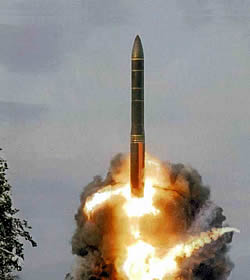 |
|
The multiple-warhead RS-24 ICBM is, according to NASIC, not a new missile but a modified version of the SS-27 (Topol-M). |
The NASIC report formally designates the “multiple” warhead RS-24 ICBM to be a modification of the SS-27 Mod 1. This has some significance because Russia under START is not allowed to increase the warhead loading on missiles declared under the treaty, but in anticipation of the treaty expiring in December 2009 apparently has been working on doing so anyway. The RS-24, which will exist in both silo and road-mobile versions, is not yet deployed but Russian military officials have said this will happen in December.
On the submarine force the modified SS-N-23 known as Sineva is listed as carrying the same number of warheads (4) as the original version, far less than the “up to 10” listed by NASIC in 2006 and by Russian news media. The range is listed as the usual 8,000+ km even though the Russian Navy claimed in October 2008 to have test-flown the missile to 11,547 km. NASIC also continues to list two remaining Typhoon-class SSBNs as capable of carrying the SS-N-20, even though the missile is reported to have been withdrawn from service. I suspect this is because the report uses START-counted missile tubes. A third Typhoon SSBN has been converted as a test platform for the SS-N-32/Bulava-30, and NASIC lists this submarine with 20 tubes for the new missile.
Interestingly, the kh-102 cruise missile, a replacement for the AS-15 long rumored to be under development, is not listed by NASIC.
Indian Nuclear Forces
Even though Indian news media reports and private/corporate institutes have reported for years that Agni I and Agni II were deployed, the NASIC report shows that operational deployment of the road-mobile Agni I SRBM has only recently begun, with “fewer than 25” missile launchers deployed. NASIC seems to back our assessment from last year that the Agni II at that time was not yet fully operational, by listing “fewer than 10” launchers deployed.
Two short-range sea-based ballistic missiles are under development: Dhanush and Sagarika. Neither is operational yet, and NASIC safely estimates that the Sagarika will become operational sometime after 2010.
Despite Indian news media reports of development of a nuclear-capable cruise missile, no mentioning of such a weapon system is made by NASIC.
Pakistani Nuclear Forces
There are fewer than 50 launchers for the road-mobile Ghaznavi and Shaheen I SRBMs listed in the NASIC report, and the 2,000+ km Shaheen II MRBM is not yet operational but may be soon. Pakistan also appears to have two nuclear-capable cruise missiles under development: the ground-launched Babur and the air-launched Ra’ad.
Other Nuclear Weapon States
Although “friendly” nuclear weapon states are not included because they are not a “threat” to the United States, the report’s section on cruise missiles is nonetheless interesting because it – unlike the ballistic missile sections – describes weapon systems of “friendly” nuclear weapon states such as France and Israel. Yet nuclear systems, such as the French ASMP-A, are excluded. Israeli submarine-based cruise missiles, which have been rumored to have nuclear capability (I’m not convinced), are not included either.
Curiously, even after two nuclear tests and the intelligence community stating for more than a decade that North Korea has nuclear weapons, the NASIC report does not list any of North Korea’s weapons as “nuclear” or “conventional or nuclear.” That is, I think, interesting.
Background Information: 2009 NASIC report | Previous NASIC reports
Strategic Failure: Congressional Strategic Posture Commission Report
 |
| The final report from the Congressional Strategic Posture Commission seems focused on hedging rather than leading. |
By Ivan Oelrich and Hans M. Kristensen
The Congressional Strategic Posture Commission report published today is definitely not the place that the President or the nation should look for new ideas on how to reduce the role of nuclear weapons and lead the world toward a world free of nuclear weapons.
Even for a compromise document written by a diverse group, it is a work of deeply disappointing failure of imagination. The recommendations can be summarized as: the nuclear world should stay pretty much the way it is but at slightly lower force levels, incrementalism is the most we can hope for, and even that should be approached very cautiously.
The report comes close to dismissing the President’s vision of a world free of nuclear weapons – and the enthusiastic support it has generated worldwide – as a utopian dream: “The conditions that might make the elimination of nuclear weapons possible are not present today and establishing such conditions would require a fundamental transformation of the world political order.” The United States should retain a viable nuclear deterrence “indefinitely.” The Commission surrenders to the nuclear problems of the world rather than recommending a proactive way forward out of the mess.
Of course, the Commission is not opposed to nuclear reductions per se and supports them under certain conditions, but it recommends that the approach “balances deterrence, arms control, and non-proliferation. Singular emphasis on one or another element,” the report says, apparently hinting at disarmament, “would reduce the nuclear security of the United States and its allies.”
If the Commission’s report is any preview of the Pentagon’s Nuclear Posture Review, we should expect minimal changes in nuclear forces, structure, or mission. The report recommends a nuclear policy of “leading and hedging” but seems to be focused on hedging.
The Nuclear Mission and Deterrence
While President Obama believes the United States should “put an end to Cold War thinking” and “reduce the role of nuclear weapons in our national security strategy, and urge others to do the same,” the Commission offers little support for this approach or analysis of what it would mean.
Indeed, while the report concludes that, “…as long as other nations have nuclear weapons, the U.S. must continue to safeguard its security by maintaining an appropriately effective nuclear deterrent force,” the Commission fails to ask fundamental questions about what nuclear weapons are for and what their character should be. This is probably because there was no consensus on these matters, but better to ask the question and admit they have no answer than to simply state over and over again that nuclear weapons are for “deterrence.” Since some will believe that “appropriately effective” is two thousand nuclear weapons and others think it will be twenty, what does the statement mean?
But it is also an assertion that should be, but is not, challenged. Does this really mean that if North Korea has one nuclear bomb, intended to counter our overwhelming conventional capability, we need to have nuclear weapons to counter it? That may be true but it is certainly not clear to us and should not be asserted as though it needs no explanation. Elsewhere the report says the United States faces decisions about how to reduce “nuclear weapons to the absolute minimum.” Again, two honest people could agree on this goal and differ by a factor of a hundred or a thousand on what an “absolute minimum” is. When the United States had 32,000 nuclear weapons, that was also considered the “absolute minimum” needed for national security.
Without examination of the mission of nuclear weapons, how can we say what their characteristics should be? Even if nuclear weapons are for deterrence, how do they deter? What are their targets? How should those targets be attacked? If we do not answer, or even ask, those questions, how can we say that we need high levels of reliability? How can we say we need land-based missiles that can be launched on a moment’s notice? How can we say we need a vast nuclear weapons complex to design complex two-stage thermonuclear weapons with hundreds of kilotons of yield? There are other examples as well, about reliability, safety, and so on, that presume missions for nuclear weapons that simply should not be presumed.
The Commission acknowledges that it is difficult to replicate the “relatively simple” deterrence calculus of the Cold War, determined by the damage inflicted, in today’s much more complex and fluid security environment. Even so, the report states, the United States still “needs a spectrum of nuclear and non-nuclear force employment options and flexibility in planning along with the traditional requirements for forces that are sufficiently lethal and certain of their result to threaten an appropriate array of targets credibly.” The justification for this sweeping conclusion about capabilities is that “the security environment has grown more complex and fluid.”
As with so many discussions of nuclear weapons, the use of the term “deterrence” in particular is confused and the logic self-referencial. Throughout the report, in too many places to cite, are repeated explicit declarations that nuclear weapons are for deterrence. The report frequently makes the mistake of talking about nuclear weapons and deterrence and then slipping into the error of assuming that deterrence must be nuclear deterrence, or the report makes true statements about deterrence but then implies that the deterrence must be effected with nuclear weapons. It repeatedly refers to our nuclear forces as our “deterrent” or our “deterrent forces” as though they were the same thing. Nuclear weapon designers are maintaining their “deterrent skills.”
In describing the role of deterrence, the Commission glosses over many important developments that have shaped U.S. nuclear policy, strategy, and doctrine over the years. “In a basic sense, the principal function of nuclear weapons has not changed in decades: deterrence. The United States has these weapons in order to create the conditions in which they are never used,” the report declares. Yet we recall hugely important developments ranging from Mutual Assured Destruction, flexible response, adaptive planning, Global Strike, and preemptive strike options, all of which changed the policies and conditions under which the weapons might be used. The report’s more accurate statement would be: “Presidents have not changed their reluctance in decades to authorize use of nuclear weapons.”
Likewise, the report does not describe the important development after the end of the Cold War, where U.S. nuclear targeting policy expanded from Russia and China and their satellite states to deterring all forms of weapons of mass destruction use by six individual countries today (some of which do not have nuclear weapons).
Non-Use and First Strike
One of the most important conclusions in the Commission report is that the “tradition of non-use serves U.S. interests and should be reinforced by U.S. policy and capabilities.” But what that implies for policies and capabilities is not explained.
Even so, the Commission concludes that not only must U.S. nuclear forces be able to retaliate against an attack, “the United States must also design its strategic forces with the objective of being able to limit damage from an attacker if a war begins.” Such damage-limitation capabilities “are important because of the possibility of accidental or unauthorized launches by a state or attacks by terrorists,” and can be achieved “not only by active defenses, such as missile defenses, “but also by the ability to attack forces that might yet be launched against the United States or its allies.”
Such first strike planning might be relevant with conventional forces against rogue states and terrorists, but first strike planning of course can also be used against other nuclear weapon states as it was during the Cold War against the Soviet Union and China. For the Commission to advocate such a mission for nuclear forces today, however, is deeply troubling because it is a primary reason why Russia insists it must have large numbers of nuclear weapons on alert – a dangerous posture that is a direct threat to the interest of the United States or its allies.
Extended deterrence
The Commission report echoes many of the points raised in the Schlesinger report from December last year about extended deterrence and views expressed by officials from some allies about the importance and mission of nuclear weapons. The good news is that the Commission report makes clear that those allies are not all of the same mind concerning the requirements for extended deterrence and assurance, and that substantive and high-level consultations are needed.
But the Commission does not explain the different capabilities that contribute to extended deterrence, but instead equates “extended deterrence” with nuclear weapons and implicitly non-strategic nuclear weapons. This after NATO for almost two decades has insisted that the U.S. non-strategic nuclear weapons deployed in Europe have no military – only a political – role.
The Commission reports that “some allies located near Russia” are saying that “U.S. non-strategic forces in Europe are essential to prevent nuclear coercion by Moscow and indeed that modernized U.S./NATO forces are essential for restoring a sense of balance in the face of Russia’s nuclear renewal.” Yet the Commission does not say that the German foreign minister has called publicly for the withdrawal of the U.S. weapons from Europe, the Belgian Senate has unanimously called for the same, and that the overwhelming majority of Europeans want the weapons to go.
Worst-case analysis is to reference only what is a concern, but that is not the full picture.
The Influence of Russia
After nearly two decades of the Clinton and Bush administrations insisting that Russia is not an adversary and not an immediate contingency for setting U.S. nuclear force levels, the Commission at least admits that Russia largely is what drives U.S. nuclear posturing, saying, “The sizing of U.S. forces remains overwhelmingly driven by the requirements of essential equivalence and strategic stability with Russia.”
In doing so, combined with numerous other references to Russia throughout the report, the Commission essentially reinstates Russia as a central pillar in U.S. nuclear posture planning. The report seems to accept that we are locked in an arms race with Russia and it is surprisingly cautious about how to free ourselves from it. It even concludes that, “the United States should not abandon strategic equivalency with Russia,” because overall equivalence is important to many allies in Europe, and that the “The United States should not cede to Russia a posture of superiority in the name of deemphasizing nuclear weapons in U.S. military strategy.”
While the commission says there is no risk of such an imbalance emerging in strategic weapons in the near-term, the situation is different with non-strategic weapons. The Commission doesn’t know how many Russia has and it can’t say how many the United States has, but while acknowledging that strict U.S.-Russian equivalence in non-strategic force numbers is unnecessary the Commission concludes that the current imbalance is stark and will become apparent as strategic weapons are reduced. This, the report correctly concludes, “points to the urgency of an arms control approach” involving non-strategic weapons.
Overall, the Commission concludes, the United States should “retain enough capacity, whether in its existing delivery systems and supply of reserve warheads or in its infrastructure, to impress upon Russian leaders the impossibility of gaining a position of nuclear supremacy over the United States by breaking out of an arms control agreement.”
Rising China
China looms in the background in many places of the report, reflecting uneasiness among the Commission members about the direction China is taking. But how that direction relates to the U.S. nuclear posture is not analyzed well. Even so, the Commission concludes, in addition to being able to deal with Russian and regional scenarios, the United States “should also retain a large enough force of nuclear weapons that China is not tempted to try to reach a posture of strategic equivalency with the United States or of strategic supremacy in the Asian theater.”
Curiously, the Commission is so concerned about China’s potential nuclear capacity that it urges that Russia – which it is otherwise concerned about – not reduce its nuclear forces too much. This is a mild reversed version of the Reagan administration’s policy that sought China as a nuclear deterrence partner against the Soviet Union.
Therefore…
Based on all of these assumptions (and many more we don’t have room to mention here), the Commission lands on a conclusion that the United States should retain the Cold War nuclear force structure of the Triad. All three legs have unique characteristics that are all needed, the Commission concludes, and because two will be left if one fails, and because “resilience and flexibility of the triad have proven valuable as the number of operationally deployed strategic nuclear weapons has declined.”
Yet the Commission could not come up with a specific force structure or a specific number for the correct size of the U.S. nuclear force, even though it was asked to do so by Congress. The issue is too complex, the authors concluded, and really should be left to deal with by the President in consultation with the military.
The United States should reduce nuclear forces only in bi-lateral negotiations with Russia (and others later), but not pursue unilateral reductions except in reserve warheads — and only if the nuclear warhead production capacity is increased.
Conclusion
In conclusion we were greatly disappointed with the Commission’s report because we see it preoccupied with hedging and failing to offer the leading that is necessary to change status quo.
Indeed, the report seems strangely detached from the President’s vision and the widespread support it and the “gang of four” op-eds have received worldwide.
It would be ironic if the Pentagon’s Nuclear Posture Review ends up recommending bigger changes than the Commission. That shouldn’t be hard.
The task at hand is how to challenge the role of nuclear weapons, we agree with the President, not perpetuate it.
Briefing on US-Russian Nuclear Forces
 |
| Vast inventories of nuclear weapons remain after the Cold War arms race ended. |
.
By Hans M. Kristensen
Russia’s nuclear forces are expected to drop well below 500 offensive strategic delivery vehicles within the next five years, less than one-third of what’s permitted by the 1991 START treaty. Unless the next U.S. Nuclear Posture Review significantly reduces the number of land-based intercontinental ballistic missiles, that single leg of the U.S. Triad of nuclear forces alone could soon include more delivery vehicles than the entire Russian strategic arsenal of land- and sea-based ballistic missiles and long-range bombers. With this in mind, Russia is MIRVing its ballistic missile to keep some level of parity with the United States.
This and more from a briefing I gave this morning at the Arms Control Association meeting Next Steps in U.S.-Russian Nuclear Arms Reductions. I was in good company with Ambassador Linton Brooks, the former U.S. chief negotiator on the START treaty, who spoke about the key issues and challenges the START follow-on negotiators will face, and Greg Thielmann, formerly senior professional staffer of the Senate Select Committee on Intelligence, who discussed how the a new agreement might be verified through START-style verification tools.
Download: Briefing on US-Russian Nuclear Forces
.
Russian Foreign Ministry Responds to FAS/NRDC Study
By Hans M. Kristensen
Russia’s Deputy Minister of Foreign Affairs, Sergey Ryabkov, gave a lengthy reaction to the FAS/NRDC report From Counterforce to Minimal Deterrence during a press conference Wednesday.
The transcript from the press conference shows that in response to a question that the “report [is] suggesting a possible retargeting of US missile from Russian cities to key economic facilities,” Ryabkov correctly stated: “I have read the report and think that in the Russian media the thesis mentioned by you was taken our of context. That is not the essence of the report.”
Instead, Ryabkov said correctly described that the report “contains an analysis of the hypothetical consequences of the use of nuclear weapons against large industrial and infrastructure facilities, as well as of what the losses might be in the case of the use of warheads of varying yield.” The rest of Ryabkov’s response is reproduced below:
| Question: The Federation of American Scientists has published a report suggesting a possible retargeting of US missiles from Russian cities to key economic facilities. How can you comment on this?
Sergey Ryabkov: I have read this report and think that in the Russian media the thesis mentioned by you was taken out of context. That is not the essence of the report. It contains an analysis of the hypothetical consequences of the use of nuclear weapons against large industrial and infrastructure facilities, as well as of what the losses might be in the case of the use of warheads of varying yield. It is deplorable and regrettable that the really existing facilities on Russian territory were chosen for such an analytical and speculative work. In my opinion, this evidences the authors’ somewhat detached attitude to the fact that much has changed in Russian-US relations in recent years. Considering Russia as a target for potential use of nuclear weapons is not a good idea. This only adds arguments to those who stick to Cold War thinking. In addition, undoubtedly, the very fact of the appearance of that report bears out our thesis that we cannot approach the question of existing potentials abstractly. Intentions, however positive and constructive today, may change tomorrow. The Federation of American Scientists is perfectly aware of this. And the very fact of the appearance of this material suggests that there needs to be serious negotiation, and that the logic of strategic equilibrium and a super-responsible approach to this sphere cannot be sacrificed to any, even the most constructive political intentions or a general favorable disposition. Intentions and dispositions are very ephemeral magnitudes, and the potentials and capacity to deal a blow, as the Association writes quite cynically and coldly about this in its report, enumerating the exponentially increasing millions of victims and speculating about how many more and what kind of warheads are needed for this knockout, are a wake-up call and a reminder to us that we live in a harsh world, whose realities can’t be disregarded.” |
.
Russian Reactions to Minimal Deterrence Study
If you have followed Russian news media recently, you might have gotten the impression that FAS and NRDC are in charge of U.S. nuclear strike planning and are recommending increasing nuclear targeting of Russia.
Of course, neither is true.
Yet major Russian news media – and apparently also the chairman of the Russia’s parliament’s international affairs committee – have so misread and misrepresented the FAS/NRDC study From Counterforce to Minimal Deterrence that we are compelled to publish this rebuttal.
Pravda Article Gets It Wrong
A Pravda article under the headline “U.S. retargets nuclear missiles to 12 Russian economic facilities” misrepresents the study as saying that the United States has already developed a new doctrine that is “going to retarget their nuclear missiles from large Russian cities to 12 most important economic facilities.”
 |
| The headline and first paragraph of this Pravda article misrepresent what the FAS/NRDC study From Counterforce to Minimal Deterrence actually says. |
.
Rather, our study does not say U.S. nuclear weapons are targeted at Russian cities. In fact, we believe cities are explicitly off-limit to U.S. nuclear strike plans unless vital military targets are present.
Nor does the study conclude it has to be 12 industrial targets. Rather, it includes a nominal list of 12 industrial targets for illustrative purposes.
Nor does the study say the U.S. has developed or is implementing a doctrine to retarget nuclear weapons at Russia’s 12 most important economic facilities. Rather, based on U.S. government documents, which we reference in the study, we estimate that U.S. nuclear strike plans already hold at risk nuclear (and other WMD) forces, command and control facilities, military and political leadership, and war-supporting infrastructure. What we’re proposing is to end nuclear planning against the first three of those target categories and limit the remaining effort – in a transition period toward elimination of nuclear weapons – against a sharply curtailed subset of the fourth target category.
Our correction sent to Pravda has so far been ignored.
|
Konstantin Kosachev Interview |
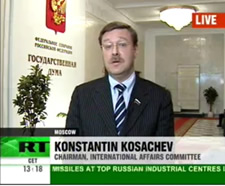 |
|
Konstantin Kosachev, the chairman of the International Affairs Committee of the Russia Duma, misrepresents the FAS/NRDC report. |
Duma Committee Chairman Also Gets It Wrong
In an interview with Russia Today, Konstantin Kosachev, who is chairman of the Russian parliament’s international affairs committee, said he had discussed the study with Carl Levin, chairman of the U.S. Senate Armed Services Committee, “in the presence of the U.S. ambassador to Moscow.” Their reaction, Kosachev said, “was something like, ‘strange, we should detarget not retarget our missiles’….”
The interviewer then suggested, and Kosachev agreed, that “reports such as this” can have the effect of “scaremongering” people and “derail relations between the United States and Russia.” Kosachev added that, “This type of reports make [Russian hawks who oppose disarmament] even stronger.”
Yet the U.S. nuclear war plan already contains strike options against facilities in Russia (and other countries with WMD) – and it’s surprising if the chairman of the International Affairs Committee is not aware of this. Russia is not an “immediate contingency,” but it’s very much a contingency because of its large numbers of nuclear weapons and history. The recommendations in the FAS/NRDC report would not “retarget” but significantly curtail existing planning.
“Detargeting” is a controversial word that refers to the 1994 bilateral agreement between Russia and the United States (a similar arrangement was made between China and the United States) according to which the two countries pledged not to store targeting coordinates for the other country in their respective missiles. As a result, U.S. Trident SLBMs and Peacekeeper ICBMs were said no longer to store target coordinates in their onboard computers, and the Minuteman III ICBMs, which for technical reasons had to store some coordinates, were targeted on the oceans.
The objective was to avoid an accidental launch of a missile striking the other country. It was a symbolic “detargeting” agreement, not a constraining “nontargeting” agreement, and both countries continue to design and maintain detailed strike plans against each other. Close to 2,000 warheads are on alert, ready to fly within minutes, despite the “detargeting” agreement.
Our report is proposing that we replace that form of planning with a much more constrained policy during the transition period where the United States and Russia figure out how to retain national security without nuclear weapons.
Vice-Chairman of Russian Council Foreign Affairs Committee Also Gets it Wrong
Vasily Likhachyov [Lykhachev], the Vice-Chairman of the Russian Council’s Foreign Affairs Committee told RIA Novosti that our proposal to go to a minimal deterrence posture represents “an infringement on the fundamental principles of international law.” The basis for this assessment apparently was the 1994 detargeting agreement that he said Russia “strictly adheres to,” and that targeting of facilities in Russia demonstrate “disrespect for the soverignty of the Russian Federation.”
Again, the 1994 detargeting agreement is not a nontargeting agreement (see above), but it is particularly interesting if a member of the Russian Council indicates that it would be against international law if the Russian military targeted the United States with nuclear weapons.
Mr. Likhachyov also questioned our calculations of expected casualties from strikes on Russian infrastructure targets arguing that “anyone who knows what a nuclear weapon is also understands that the effect of an atomic explosion spreads over tens and even hundreds of kilometers.”
But as we explain in the report, the selection of “soft” surface targets such as industry allows the Optimum Height of Burst to be set high above the surface, thus avoiding the generation of large amounts of fallout that Mr. Likhachyov appears to assume comes from any nuclear detonation.
Resources: FAS/NRDC Press Release and Full Report
Study Calls for New U.S. Nuclear Weapons Targeting Policy
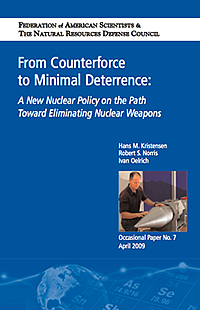 |
| Click on image for PDF-version of full report. |
By Hans M. Kristensen
The Federation of American Scientists and Natural Resources Defense Council today published a study that calls for fundamental changes in the way the United States military plans for using nuclear weapons.
The study From Counterforce to Minimal Deterrence: A New Nuclear Policy on the Path Toward Eliminating Nuclear Weapons recommends abandoning the decades-old “counterforce” doctrine and replacing it with a new and much less ambitious targeting policy the authors call Minimal Deterrence. [Update: see Washington Post – Report Urges Updating of Nuclear Weapons Policy]
Global Security Newswire reported last week that Department of Defense officials have concluded that significant reductions to the nuclear arsenal cannot be made unless President Barack Obama scales back the nation’s strategic war plan. The FAS/NRDC report presents a plan for how to do that.
The last time outdated nuclear guidance stood in the way of nuclear cuts was in 1997, when then President Clinton had to change President Reagan’s 17-year old guidance to enable U.S. Strategic Command (STRATCOM) to go to the START-III force level that the Bush administration subsequently adopted as the Moscow Treaty force level. The series of STRATCOM force structure studies examining lower force levels is described in The Matrix of Deterrence.
Resources: Full Report | US Nuclear Forces 2009 | United States Reaches Moscow Treaty Warhead Limit Early | Press Conference Video
